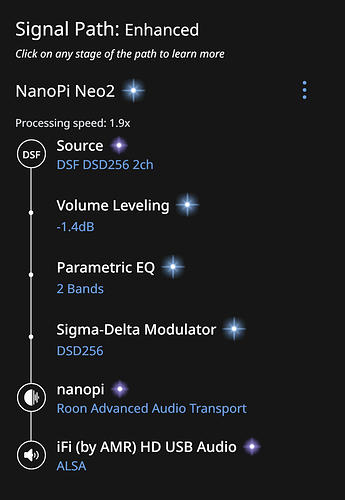I don’t know much about it, but one of the distinctions between convolution and EQ is that convolution usually refers to an FIR (finite impulse response) design like a linear phase filter, whereas many EQ filters are IIR (infinite impulse response) which shifts phase. I don’t know whether Roon uses FIR or IIR in PEQ.
FIR takes more computing power than IIR, but you can fold many DSP functions into a single impulse response file and convolve it as a single operation, preserving phase.
The above is a bit simplistic, because convolution is a mathematical operation, whereas FIR and IIR are filter designs. In theory you could use a convolution function to implement either an FIR or an IIR filter, but FIR is more usual because of the advantages set out below.
Here’s a bit more about them all:
An FIR filter has a number of useful properties which sometimes make it preferable to an infinite impulse response (IIR) filter. FIR filters:
- Require no feedback. This means that any rounding errors are not compounded by summed iterations. The same relative error occurs in each calculation. This also makes implementation simpler.
- Are inherently stable, since the output is a sum of a finite number of finite multiples of the input values, so can be no greater than {\displaystyle \scriptstyle \sum |b_{i}|}
 times the largest value appearing in the input.
times the largest value appearing in the input.
- Can easily be designed to be linear phase by making the coefficient sequence symmetric. This property is sometimes desired for phase-sensitive applications, for example data communications, seismology, crossover filters, and mastering.
The main disadvantage of FIR filters is that considerably more computation power in a general purpose processor is required compared to an IIR filter with similar sharpness or selectivity, especially when low frequency (relative to the sample rate) cutoffs are needed. However, many digital signal processors provide specialized hardware features to make FIR filters approximately as efficient as IIR for many applications.
Source
The main advantage digital IIR filters have over FIR filters is their efficiency in implementation, in order to meet a specification in terms of passband, stopband, ripple, and/or roll-off. Such a set of specifications can be accomplished with a lower order ( Q in the above formulae) IIR filter than would be required for an FIR filter meeting the same requirements. If implemented in a signal processor, this implies a correspondingly fewer number of calculations per time step; the computational savings is often of a rather large factor.
On the other hand, FIR filters can be easier to design, for instance, to match a particular frequency response requirement. This is particularly true when the requirement is not one of the usual cases (high-pass, low-pass, notch, etc.) which have been studied and optimized for analog filters. Also FIR filters can be easily made to be linear phase (constant group delay vs frequency)—a property that is not easily met using IIR filters and then only as an approximation (for instance with the Bessel filter). Another issue regarding digital IIR filters is the potential for limit cycle behavior when idle, due to the feedback system in conjunction with quantization.
Source
In mathematics (in particular, functional analysis) convolution is a mathematical operation on two functions (f and g) that produces a third function expressing how the shape of one is modified by the other. The term convolution refers to both the result function and to the process of computing it. It is defined as the integral of the product of the two functions after one is reversed and shifted.
Source

